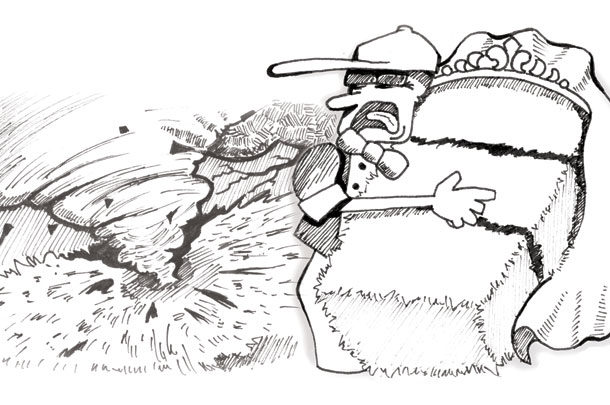In both cases, a less-than-ideal outcome may be due to environmental conditions. And all too often, we do not have alternative or back-up plans in place.
Mother Nature seems increasingly variable. Locations typically prone to droughty conditions have turned into near-tropical conditions with excessive rainfall and floods. In recent years, farmers have experienced freezing conditions during corn silage and high-moisture corn harvest.
For the following harvest season, it will be difficult to forecast the exact outcome, but much like what happens when the estranged relative arrives to the wedding, I can project with certainty volatile conditions will be in play.
We can minimize the impact extreme weather conditions have upon forage harvest by having a sound plan in place. Similar to a SWAT team or emergency response crew, when the unexpected happens, the team has a plan in place.
The plan has been discussed ahead of the event so the acting parties can take action with confidence. Forage harvest during drought, or around torrential rains, should be no different. Your harvest and management team needs to have a plan in place.
Writing the extreme harvest game plan
The most progressive growers, harvest crews and dairy or feedlot owners and managers meet months ahead of the forage season. The agenda should include reviewing the plan of action with extreme weather conditions.
Extreme weather can be short-term, damaging the standing crop or delaying cutting, or may hit during harvest. Extended extreme weather, such as with a drought or flood, can entirely alter the forage season and crops.
With short-term extreme weather, such as a rain event delaying the crop or hail and wind damaging the crop, plan for what should be done under altered harvest conditions.
If rain is in the forecast, and crop quality is in danger of being far inferior to what is desired, weigh the benefits and drawbacks to expedited harvest. Often, harvest teams will cut alfalfa or grass ahead of forecasted rain and then chop the forage at greater than the critical threshold of 65 to 75 percent moisture.
In many cases, wet forage leads to large fermentation losses, butyric acid and clostridium or pathogenic bacterial growth. These further feed losses and health challenges would not be present if forage would have been ideally preserved (i.e., drier).
The better option may be to delay harvest, recognizing a lesser crop quality with the cutting but then being more aggressive with cuttings to follow and cutting earlier to balance the poor-quality with the greater-quality feed.
If the crop is damaged, such as goose-necked or hail-damaged corn, work with your agronomist to assess the damage extent and understand if the crop will recover.
If the crop is damaged to the near-death point, cut the crop and harvest as soon as possible. Make added efforts to ensure adequate fermentation if ensiling, including increasing inoculant or acid rate, exceptional packing and density, and seal the silo quickly.
Goose-necked and damaged corn can often recover and make reasonable forage. Perhaps additional grain acreage can be harvested as forage at bargain values to make up for lesser tonnage. With damaged crops, also consider additional fungicide application to mitigate fungal infestation.
With long-term extreme weather, alter the crop and avoid rash decisions. In drought conditions, where corn is near the point of death, watch the ear leaf before cutting and chopping prematurely.
Professor Joe Lauer with the University of Wisconsin has taught if the leaf beneath the ear is still green, the plant is still alive and has the chance to recover with rain.
In cases where early season drought led to a corn crop failure, work with your trusted agronomist and seed advisers closely. These teammates can help you manage planting sorghum, sudangrass, milo, millet (or tropical grasses that do better in arid conditions) or forage oats to salvage tonnage from your acreage.
When extreme conditions hit during harvest, such as rain after forage is lying in the field, make decisions based upon the expected amount of rain.
With moderate amounts of rain forecast, allow the lying crop to be rained on rather than rushing to chop and ensile at a moisture level too wet (for the reasons mentioned above). With torrential rains forecasted, to the point that the crop may be lost, chopping too wet may be the only option.
Chris Wacek-Driver has taught when chopping alfalfa at 65 to 75 percent moisture (or grass for silage), allow the feed to ferment for two or three weeks, but then feed quickly.
Professor Limin Kung has taught that the feed will likely not reach stability and will deteriorate over time, getting worse with months to come. Capture the feed value before the deterioration point.
There are other extreme weather conditions that can happen (i.e., flooding) which were not discussed here, but with some preplanning you can avoid the catastrophic outcome – as in the case of an angry in-law at a wedding party. Bring your agronomy and seed advisers, harvest crew and nutritionist to the table for preparatory meetings.
Also during these meetings, review the season’s successes and opportunities where the team can do better in years ahead.… variable environmental conditions are not going away. ![]()
ILLUSTRATION: Illustrated by Corey Lewis.

-
John Goeser
- Director of Nutrition,
- Research and Innovation
- Rock River Laboratory Inc.
- Email John Goeser











